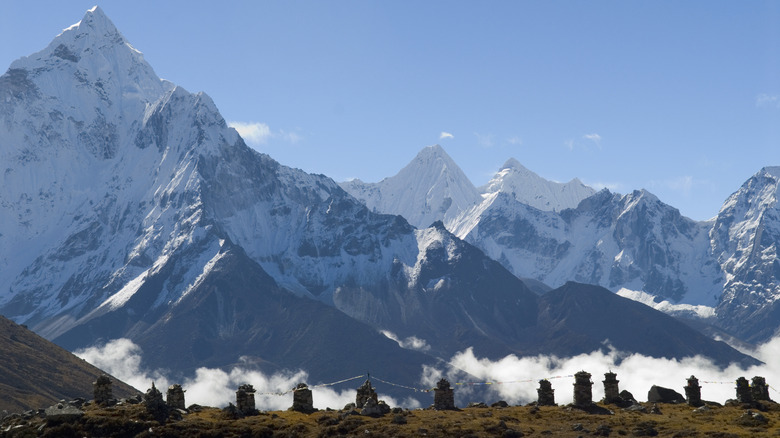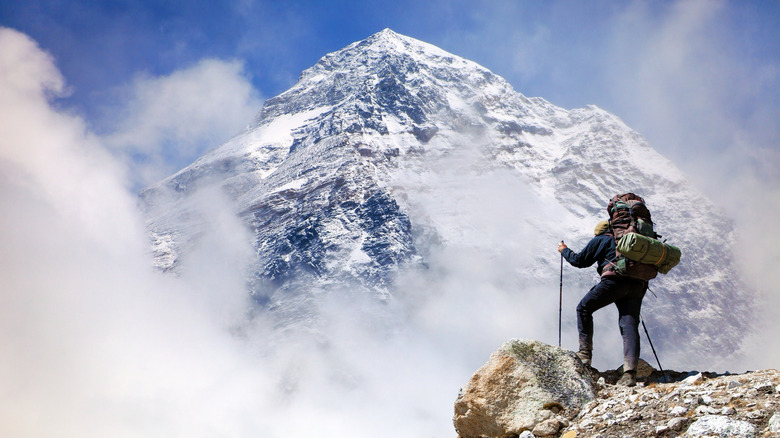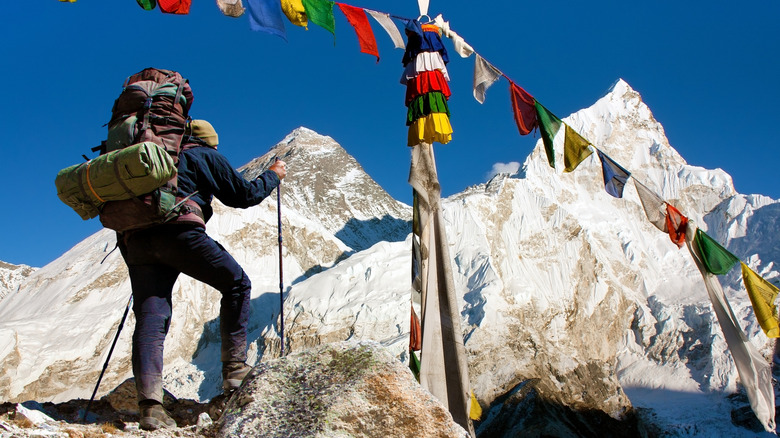The Devastating Amount Of Lives Mt. Everest Has Claimed
The danger — and the allure — of the world's highest mountains is undeniable. Mount Everest, the tallest in the world at 29,032 feet, has gained a legendary reputation with a sheen of adventure and, on a darker note, peril. Since expeditions on Everest began in the 1920s, around 330 people have died on the mountain. Due to the expense and difficulty of retrieving bodies from Everest, around 200 bodies still remain on its slopes, frozen in time. However, the many deaths that occur on Sagarmatha, as it's locally known ("Goddess of the Sky" in Nepali), don't seem to deter many mountaineers from making the trek. If anything, the inherent danger is just one of the fascinating facts about Mount Everest that adds to its mystique.
Due to improvements in mapping technology, climbing gear, and evacuation possibilities, in addition to increased knowledge of climbing, altitude, and weather, one might assume that, in the years that alpinists from all over the world have been summiting (or attempting to summit) Mount Everest, the total number of deaths per year would decrease. Unfortunately, this is far from true. Sadly, 2023 was one of the deadliest years in the mountain's history, with a total death toll of 17. There have been deaths every single year since the 1920s, except for 1977 and 2020 (when the government suspended permits during the COVID-19 pandemic). The reasons for deaths on Mount Everest are complex, and future safety on the mountain remains uncertain despite modern advancements.
Why have so many people died on Everest in recent years?
Despite improved safety measures on Everest — established routes, lighter oxygen canisters, warmer gear — the chance of death remains about one in 10 for every successful ascent and one in 20 overall. The Death Zone (above 26,247 feet) on Everest is the most perilous. The thin air makes our bodies, desperate for oxygen, rebel. Brain swelling can induce "summit fever," causing you to make fatal mistakes, while increased circulation to the lungs can cause you to drown in your own blood. The longer you stay in the Death Zone, the more lethal. If altitude sickness doesn't get you, the freezing temperatures, severe weather, or sudden avalanches just might.
2023 was the deadliest year on Everest — but why? Theories abound, but two culprits are climate change and overcrowding. Unpredictable weather made the snow too soft, and a late cold snap shortened the safe climbing window, which led to rushed ascents. Additionally, Nepal issued more permits than ever before — 478 (although it's worth noting that there were nine deaths on Everest in 2024 when Nepal issued 421 permits). The price to climb Mount Everest is higher than you think, but the lack of regulations led to inexperienced climbers using lower-cost companies that didn't have the necessary emergency preparedness.
Nepal now requires climbers to wear trackers, and permits are slated to be even pricier in 2025, so the number of climbers (and potential fatalities) may dwindle. Nonetheless, the risk remains. Why, with such a chance of death, illness, and injury, would anyone want to climb Everest? Perhaps "because it's there," in the words of mountaineer George Mallory, who disappeared on the mountain in 1924 (via Britannica). Or, maybe it's the legends that get us.
The mystery of climbing deaths on Everest and beyond
Death during an expedition on one of the most difficult mountains to climb in the world, like Everest, tends to take on an air of mystery. The remoteness of the mountain means the events are murky by nature. Survivors, besieged by illness, injury, and trauma, can't always provide an accurate account. Some mountaineers disappear into the mountains, never seen again, with their bodies discovered years later — if it all.
On average, retrieving a single body from Everest costs $75,000 and can require up to eight rescuers. A Nepalese task force, led by the military and sherpas, is annually assigned to hauling out bodies, as well as any leftover trash. Although controversial due to costs and dangers, the rescue team leader, Major Aditya Karki, considers it worthwhile, saying, "If we keep leaving them behind, our mountains will turn into a graveyard." The sherpa leader of the expedition, Tshiring Jangbu Sherpa, agrees, "The mountains have given us mountaineers so many opportunities. I feel that we have to give back to them" (via CBS News).
Despite these efforts, many bodies remain — some even as landmarks. "Green Boots" and "Sleeping Beauty" are two (in)famous bodies that were moved out of respect (although not off the mountain). Green Boots is likely Tsewang Paljor or his climbing partner, Lance Naik, who both perished in 1996. Sleeping Beauty is Francys Arsentiev, who died in 1998. Many bodies prevail as in death — still brightly clothed, still wearing climbing spikes. The famous George Mallory was found in 1999, with his name stitched into his jacket and letters in his pockets. As the saying goes, "every corpse on Everest was once a highly motivated individual." Ultimately, even the best climber relies on luck. The mountain always has the last word.


